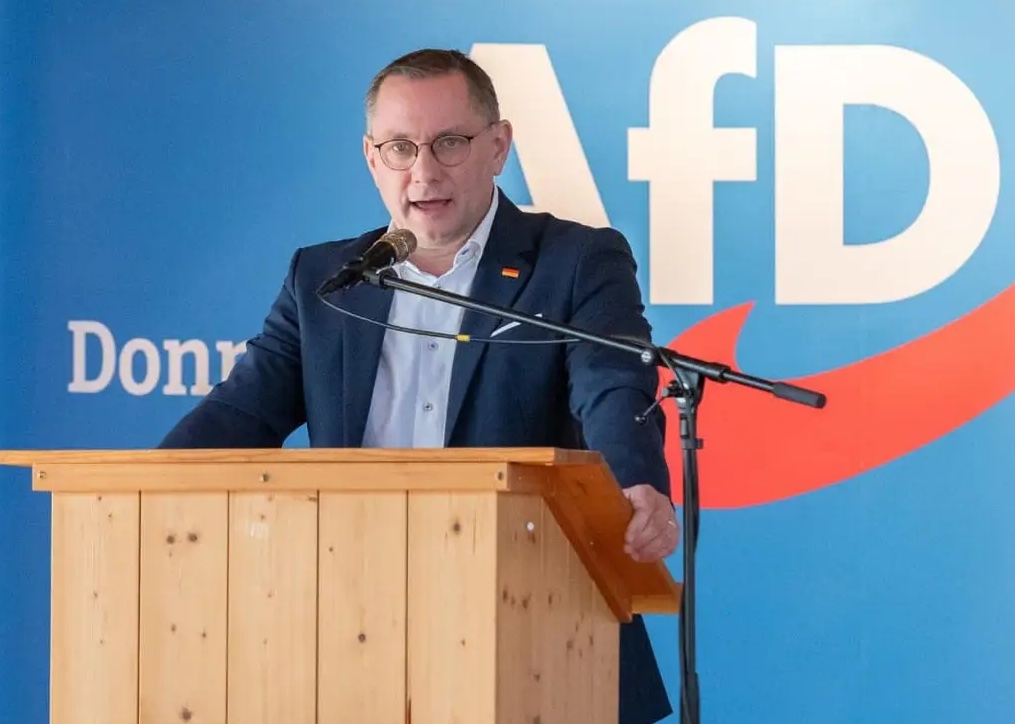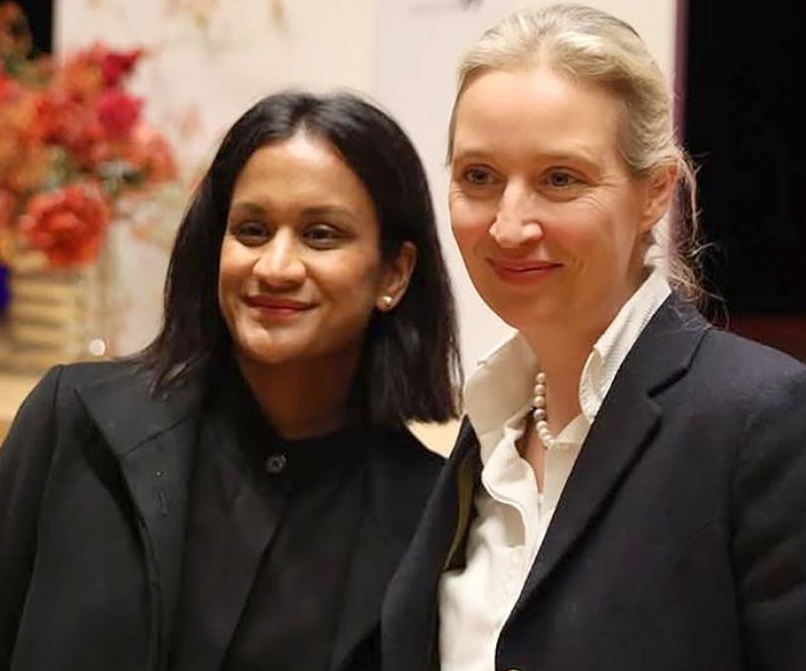The anti-immigration party AfD (‘Alternative for Germany’) has won the strongest ‘right wing’ vote in postwar German history.
In the party list section of yesterday’s federal election, AfD took 20.8%, up from 10.5% in 2021. They will have 152 MPs, up from 83 in 2021. (By the time this year’s election was called, those 83 had been reduced by resignations/expulsions to 76.)
The result was precisely in line with opinion polls during the campaign which were remarkably consistent in giving AfD 20-21%, with only one outlier putting them on 25%. AfD achieved a historic second place in this election, ahead of the social democratic SPD on 16.4%, but behind the conservative CDU/CSU on 28.5%.
Predictably the best AfD results were in the old East German regions: 38.6% in Thuringia, 37.3% in Saxony, and 37.1% in Saxony Anhalt. But they also achieved significant progress in parts of western and southern Germany: 20.1% in Rhineland Palatinate, 19.8% in Baden Württemberg, and 19% in Bavaria. Their weakest regions were again the traditionally leftwing cities of Hamburg (10.9%), Berlin (15.2%), and Bremen (15.1%).
The pro-Kremlin, neo-Stalinist party BSW fell a fraction below the 5% threshold, meaning it will have no seats. This is a humiliation for its leader, the half-Iranian Sahra Wagenknecht, who at the start of the campaign had hopes of becoming the main leader of Germany’s far left. The liberal FDP (which until last year’s government crisis was part of the governing coalition) is also wiped out on 4.3%, ending the political career of its leader, former Finance Minister Christian Lindner.
In addition to Lindner and Wagenknecht, another high profile politician to lose his seat was Robert Habeck, Vice Chancellor in the outgoing government and former co-leader of the Greens, who lost his Flensburg – Schleswig constituency to the CDU. Overall the Greens didn’t suffer so bad a defeat as their former coalition partners SPD and FDP, but they still fell from 14.7% to 11.6%. Many of these former Green voters went to a surprisingly resurgent far left party Die Linke, who rose from 4.9% to 8.8%.
All of the results have now been declared, and AfD will have 152 seats in the new Bundestag. Germany’s electoral system is a combination of Westminster-style elections of this kind, plus a top-up system by which additional members are elected from party lists, so as to ensure that any party achieving more than 5% nationwide has a proportional number of MPs in the Bundestag (regardless of how many individual constituencies it has won.)

Among the early AfD winners was the party’s co-chairman Tino Chrupalla, who retained Görlitz (in Saxony) with 48.9%, up from 35.8% four years ago. Also in Saxony (part of the former East Germany) AfD’s Carolin Bachmann was re-elected in Mittelsachsen with 45.4%, up from 33.4% last time.
These were already established AfD strongholds, but there were also some gains from other parties even at constituency level. These included the Brandenburg constituency of Oberhavel – Havelland II (just north of Berlin) which the AfD’s Andreas Galau gained from the SPD on a fragmented poll with 30.8%.
Another gain was the Thuringian city of Jena, which the SPD managed to win in 2021 with only 20.1%, but which AfD won yesterday with 32.5%. Remarkably, the SPD collapsed to fifth place in Jena with only 11.7%, and the far-left Die Linke finished second here behind AfD.
And yet another AfD gain in the old east was in the northern of the two Leipzig constituencies, which AfD gained from the CDU’s Jens Lehmann (a former professional cyclist and Olympic champion). Here the AfD vote increased from 15.9% to 25%.
Very importantly, AfD has made big advances in two constituencies in the old West Germany, both of them in industrial cities, and both gained (in the list vote section of the ballot) from the SPD. In Kaiserslautern, AfD more than doubled their vote from 12% to 25.5%. And in Gelsenkirchen they advanced from 14% to 25.8%. In each case however the SPD held onto the constituency seats thanks to tactical support from Greens and other leftwingers, while losing to AfD on the party list.
The overall result is the highest AfD vote in any nationwide election, easily beating the 15.9% achieved in last year’s European election. This is by far the highest ‘far right’ vote and the lowest SPD vote in postwar German history.
However, there is no chance of AfD becoming part of a coalition government: CDU leader Friedrich Merz is certain to be the next Chancellor and he will almost certainly seek a coalition with the SPD, which is bound to acquire a new leader (probably the popular defence minister Boris Pistorius, replacing defeated Chancellor Olaf Scholz) after this defeat. It’s far from clear what the principles underlying such a government will be (where domestic policy is concerned), but the CDU and SPD combined would have an overall majority of 26.
Once AfD is excluded from consideration, no other feasible combination of parties would achieve the necessary 316 seats.
Founded in 2013 as a Eurosceptic and what British readers would see as economically Thatcherite party, AfD moved considerably to the ‘right’ and reinvented itself as primarily an anti-immigration party, especially in response to Chancellor Angela Merkel’s decision to admit vast numbers of asylum seekers.
In contrast to Reform UK, AfD seems to have an even stronger appeal to young voters than to older Germans. Among those in their 60s and 70s, the social democrats have retained second place ahead of AfD, but among the 25-34 age group AfD is the largest single party on 22%.
As in the USA, however, there is a marked gender divide, with German women much more likely than men to vote for leftwing parties. 10% of women (according to the exit poll) supported the far-left Die Linke, with the SPD and AfD tied for second place each with 17% of women. Among male voters there is an eight-point gap, with AfD on 23% and SPD on only 15%. The organised left (even the centre left) is ceasing to be the party of male industrial workers, and becoming the party of those female graduates who obsess about issues such as abortion.
The March-April edition of H&D will include comments on these historic shifts in German politics.
AfD’s rise has coincided with big changes on the more radical racial nationalist scene in Germany, where the NPD (which for years had been the largest racial nationalist party and elected members to several German regional parliaments) has been in crisis. NPD members voted to rename the party as Heimat (Homeland – no connection to the UK’s Homeland Party), while a significant number of former NPD activists broke away to form a new party Dritte Weg (Third Way – again no connection to the former party of that name in the UK).
For now, genuine racial nationalists in Germany have opted out of the federal election, but AfD’s extremely pro-Moscow stance and its wobbly position on racial matters is likely in due course to push more radical patriots in the direction of Dritte Weg, which is rooted in a principled racial nationalism and defence of Europe’s borders against both immigration and Russian invasion/subversion.


